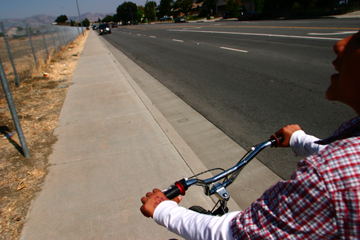
Last master plan saw little change in San Benito County
There are just a few more days left of the annual
”
Bike to Work
”
week in Hollister
– and anyone who has been out on the streets lately on a
two-wheeler knows that is easier said than done.
Last master plan saw little change in San Benito County
There are just a few more days left of the annual “Bike to Work” week in Hollister – and anyone who has been out on the streets lately on a two-wheeler knows that is easier said than done.
A ride down many streets in Hollister leads to dead-end bike lanes. Bike paths that are separated from the streets are littered with glass and other litter. In downtown Hollister, there are no marked bike lanes and few places available to lock up a bike. In general, the atmosphere is not encouraging for those – experienced riders or beginners – who want to forego a car trip and hop on their bikes.
But as a new evolution of the county bikeways master plan is set to start in the 2007-2008 fiscal year, there is an opportunity to change that. San Benito has long had a master plan to make the county more bicycle and pedestrian friendly but has been short of funds to implement many of the identified projects.
A 2001 map of proposed bikeways includes a variety of projects such as a bike path along the San Benito River from Hollister to Tres Pinos, a rail side path from downtown Hollister to Gilroy and plenty of other bike paths and bike lanes.
But a look at the map’s key reveals that the dark circles of class I bike paths – which are separated from streets – and class II bike lanes – which are along the shoulders of streets and clearly marked as bike lanes – are pathways that are proposed. The markers for existing pathways equal less than ten miles in the entire county.
The bike lanes that do exist, such as a lane along Santa Ana Road, runs for a few miles until the shoulder of the road disappears.
“Most bike paths in Hollister are fragmented and not very long,” said Brian Lucas, the owner of Off the Chain, a local bicycle shop. “A major thing is they have to be continuous. [When they end] there is no shoulder at that point and it becomes dangerous for people to be using.”
As an experienced bicyclist who leads weekly bike rides on Sundays, Lucas prefers bike lanes along the shoulders of streets to the separated bike paths that are sometimes preferred around schools.
“Some of the bike paths have not been cleaned,” he said. “Everyone kind of avoids them.”
The use of bike paths for a variety of recreational activities and the difference in experience of riders can be a draw back for some bicyclists, he said.
“Hollister is a great place to ride a road bike,” he said. “Bike paths are not very useful for experienced bike riders who travel more than a few miles.”
Regardless of the debate about which type of bikeways are best, San Benito has a shortage of all of them.
In the more than six years Lucas has lived and bicycled in the county, he has seen little addition to the bikeways.
“I’ve only seen one, maybe two-and-a-half miles since I got here,” he said.
The 2001 document included 15 projects, some which were expected to take up to 20 years to complete and others that could be done in a few years. One project that has been completed, according to Veronica Lezama, a transportation planner and coordinator of the County’s Rideshare program, is a bike lane from Southside Road to Ladd Lane.
“In 2005, we implemented and constructed a Southside Road bike lane from the labor camp to Ladd Lane [Elementary School],” Lezama said. “It created connectivity with other existing routes.”
The county also has plans to break ground on a bikeway project in San Juan in 2008 that will provide a safe route to Anzar High School, Lezama said.
Some San Juan parents have said the only safe way to get to Anzar High School across Hwy. 156 is by car.
Though the county has had money to update the master plan since it was first put together in 1990, it doesn’t always follow that there is enough money to complete all of the projects identified.
“The only challenge we face is the lack of funding,” Lezama said. “Hopefully we can identify a priority list on what we want to construct first and take it from there.”
Much of the funding for bikeway projects has been from federal sources as legislators have pushed for alternative means of transportation.
“Right now, we lost some of our federal funding that we use for bike lanes,” Lezama said. “We will be looking into other sources.”
When revisions begin for the master bike plan, county staff will hold public meetings to gather input from those who actually use the existing bikeways or those who want to see improvements.
“With a new update we will do a lot of public outreach,” Lezama said.
Melissa Flores can be reached at mf*****@**********ws.com.









